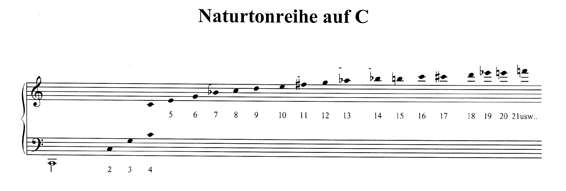The Pythagorean scale: The physics of sound
Each tone of an organ pipe is not a single but a composite sound of a whole series of tones. However, these are not arbitrary, but stand in fixed relationships to each other. The interval ratios have been known since ancient times (Pythagoras). The fundamental of the respective pipe/reed produces a sequence of harmonics, their number and individual strength depending on the construction of the pipe. The frequencies of the individual tones in the Pythagorean scale are related to each other like their individual figures. The oscillation number of the fundamental (tone 1) multiplies correspondingly for the higher harmonics (tone 2 ff.) by twice, threefold, etc. etc. A special feature of stopped flue pipes and reeds with cylindrical resonators is the absence of even-numbered harmonics in the sound spectrum: their sound consists only of natural tones 1 (fundamental), 3-5-7 ..., etc. while the other pipes produce a continuous series.

Every pitch in this series requires a higher energy level to sound than the previous one. This is one of the causes of the relative scarcity of higher harmonics of flue pipes, in which „only" air vibrates, while metal reeds require considerably more energy to vibrate at all, but also release more energy and thus produce more harmonics in number, height and intensity. For example, a flue pipe with more than four detectable overtones in the sound spectrum is considered quite rich in harmonics while an average reed pipe, on the other hand, easily produces a dozen or more harmonics.
The relative strength of the harmonics in comparison to the fundamental is also an important factor. As a rule, the fundamental usually is the strongest frequency in the sound spectrum of a pipe, but by narrowing the pipe diameters while maintaining pipe lenghts the fundamental can be relatively weakened and the harmonics strengthened; extremely narrow diameters can cause a fundamental to vanish completely and the pipe to overblow into the next higher frequency of the series. In contrast, when constructing the Quintadena rank, great care is taken to ensure that the natural tones 1 and 3 can be heard (approximately) of equal strength.
Yet another sound factor is influenced in this way: the formation of the so-called formants. It is a phenomenon familiar to everyone, namely the formation of vowels, because the human vocal apparatus ultimately represents a similar combination of fundamental generator (the vocal chords in the larynx) and an flexible attachment (especially the oral cavity with the tongue), which can be shaped in such a way that individual frequency ranges can be preferred and other attenuated.
For the vowel „oo", approximately all harmonics above about 500 Hz are strongly attenuated; "aah" is produced by relative amplification of the frequencies around 1000 Hz, „ee" by attenuation of low frequencies and amplification of the range above about 2000 Hz. Finally, „ä/ay" - between „aah" and „ee" - has a broad band of medium and higher frequencies, which is formed in the vocal apparatus in cavities in the area of the nose and forehead, which is why this sound area is often characterized as "nasal".
In the organ, formants are created in a very similar way, both by damping certain frequency ranges (for example, with individual reed pipes) and by amplifying others (for example, when the sounds of the principal registers of different layers add up in the plenum). The consequence of these phenomena can be traced, for example, in solo reeds (such as vox humana), which appear to "sing without words", as the formants oscillate across the range of the register from „oo" to „aw" to „aa" to „ü" to „ee". A good organ sound develops a distinct „aah"-formant, which while ascending - without too much nasal „ä" in between - merges into the „ee" supported by the mixtures. Flue ranks, especially stopped, should retain their „oo" formant as far as possible into the high tonal ranges, whereas in the sound of the chimney flute, in addition to the "oo" a perceptible "ee" component is desired.
No other musical instrument is in this way able to develop a formant spectrum that corresponds to the range of the human voice. This also contributes significantly to the fascination of the organ.
© Greifenberger Institut für Musikinstrumentenkunde | info@greifenberger-institut.de



